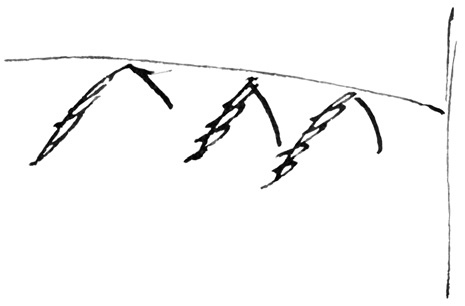From W. T. Thiselton-Dyer 28 September 1875
Royal Gardens Kew
Septr. 28. 75
Dear Mr Darwin
Before I heard from you I found in another number the illustration of the Citron-orange and here is a rough tracing of it.1
In the Gardeners’ Chronicle Septr. 25. p. 398 there is a remarkable account of some hybrid Aroids by Prof. Karl Koch of Berlin which exhibit in a modified degree the same curious phenomena of dissociation which are so wonderful in Cytisus Adami.2
When I was in Switzerland I collected a head of fruits of a species of Geum which externally are in no respect different to those of some species Anemone or Clematis. You might like to try if these will bury themselves (if they are not spoilt by pressure—but probably they would come all right after damping and then drying) It is very curious finding fruits so similar in two so different natural orders.3
We have now at Kew a sensitive plant Schrankia aculeata which was new to me. The pinnæ drop when the pinnules close but the main rachis does not as in mimosa pudica4

I am afraid I trouble you with very trivial matters
Yours very truly | W. T. Thiselton Dyer
CD annotations
Footnotes
Bibliography
Correspondence: The correspondence of Charles Darwin. Edited by Frederick Burkhardt et al. 29 vols to date. Cambridge: Cambridge University Press. 1985–.
Movement in plants: The power of movement in plants. By Charles Darwin. Assisted by Francis Darwin. London: John Murray. 1880.
Variation: The variation of animals and plants under domestication. By Charles Darwin. 2 vols. London: John Murray. 1868.
Summary
Reports on Schrankia aculeata in which pinna and pinnule are sensitive, but, unlike Mimosa pudica, rachis does not move.
Letter details
- Letter no.
- DCP-LETT-10174
- From
- William Turner Thiselton-Dyer
- To
- Charles Robert Darwin
- Sent from
- Kew
- Source of text
- DAR 209.6: 208
- Physical description
- ALS 4pp †
Please cite as
Darwin Correspondence Project, “Letter no. 10174,” accessed on 19 April 2024, https://www.darwinproject.ac.uk/letter/?docId=letters/DCP-LETT-10174.xml
Also published in The Correspondence of Charles Darwin, vol. 23


